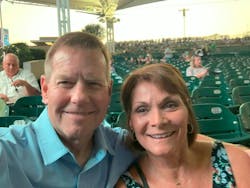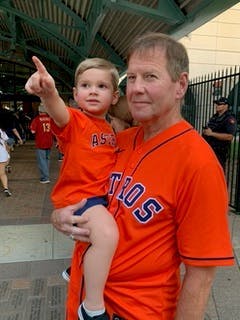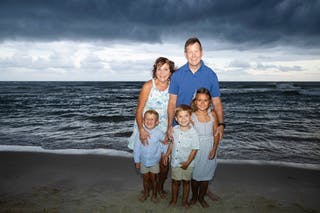Sandy Vasser: At the forefront of oil and gas process automation
Key highlights:
- The article follows Sandy Vasser’s 39-year journey, showcasing how traditional engineering practices evolved through innovation.
- Vasser's “It Just Happens” initiative offers a blueprint for how standardization and automation can dramatically reduce complexity, costs, and timelines in large-scale process engineering projects.
- It highlights effective collaboration with major vendors (e.g., Siemens, Rockwell, Emerson) to create universal solutions—an essential insight for engineers managing complex, multi-vendor systems.
Growing up in Alabama often means making a choice— “Roll Tide” or “War Eagle.” More often than not, you’re born into your football allegiance for Alabama or Auburn. Other times, your choices put you at odds with those closest to you. Sandy Vasser admits he was a big Alabama Crimson Tide fan growing up, while his father was a fan of the Auburn Tigers.
“We’d watch the [Iron Bowl] every year, and I rooted for Alabama and he rooted for Auburn,” Vasser recalls. This was during the period of Bear Bryant and Joe Namath at Alabama and Shug Jordan and Pat Sullivan at Auburn.
Gridiron allegiances aside, the two shared a common interest that would eventually lead to a plot twist on the level of a Chris Davis kick-six play (if you know, you know). Vasser says he got his interest in engineering from his dad, a physicist who practiced engineering, and eventually became engineering manager at an International Paper Co. plant.
He and his dad did a lot of Heathkit projects together, and Vasser says it’s where he got interested in electrical engineering. When it came time to pick a college, the lifelong (to that point) ‘Bama fan, chose Auburn, of all places.
He knew it would make his dad happy to hear his choice, but still, the rivalry ran deep and he fesses up to having the hardest time telling him where he was going to study. “I waited until a month before I left for school to tell him,” Vasser says. “I didn’t want to admit I was going to Auburn.”
But he did and earned his bachelor’s degree in electrical engineering and now, “I’m the biggest Auburn fan.”
Striking with oil and gas
“It seemed to be a perfect match, so I went,” he says.
He started with Exxon Gas System in Houston. The company distributed natural gas from King Ranch to Tyler, Texas. He recalls nine compressor stations in the control system, which was controlled by a PDP-8 microcomputer. “It was my first experience with automation,” he says.
Vasser’s job was to justify replacing the PDP-8, which was termed a high-speed computer, but it wasn’t very fast by modern standards. He was then given responsibility for the control system in a new compressor station, he spent time in the field terminating field I/O.
He eventually got approval to replace the PDP-8, but was transferred to another division before it could be replaced.
First-of-a-kind FPSO
Vasser’s next stop took him offshore California. Located in 850 feet of water, the single production and oil processing platform vessel which was an innovative floating plant developed in response to Exxon’s difficulty getting approvals for a plant onshore north of Santa Barbara, CA. So, Exxon moved it offshore in federal deepwater. “Three miles out to sea, we built what turned out to be the first floating production, storage and offloading (FPSO) vessel,” Vasser says.
Hear more from Sandy Vasser
Listen to the Control Amplified podcast featuring more from Sandy Vasser on his journey through his 39-year process-engineering career, the changing automation landscape and the evolution of the process automation field.
“It was quite unique. We didn’t call them FPSOs back then [in the early 1980s], just offshore storage and treatment facilities (OS&T),” he says.
Following this assignment, Vasser was assigned to a team in Houston that designed the topsides for two more platforms, an onshore oil processing plant, an onshore gas plant, a cogeneration power plant, and an export terminal, all to replace the offshore processing facility. It was all part of the Santa Ynez Unit in Southern California.
Following the completion of the designs, Vasser moved to California to support the construction of the new onshore facilities. Following startup, he remained in California supporting the three offshore platforms and the onshore facilities for several years.
Changing automation
Just before 2000, Vasser found himself back in Houston, working at Exxon Upstream Development Co., which was responsible for all upstream projects worldwide. “We had about 100 projects in our portfolio—all multibillion-dollar projects—and we were set up to execute about 25 at a time,” he recalls.
Exxon wanted an experienced group working on its endeavor, and Vasser was part of a team of experts, who all had more than 20 years of experience. Shortly after he began with the development company, Exxon and Mobil merged, and everything moved to a large campus in Spring, Texas, in the Houston suburbs.
Vasser led a team of 125 professional electrical and automation engineers and technicians responsible for the design, construction, and startup of the power and automation systems for upstream projects. Considering the large volume of ongoing projects and the limited resources, he knew that different project approaches were necessary to be consistently successful.
He started an initiative called, “It Just Happens”, which challenged every historical project practice and procedure in the power and automation disciplines. The idea was to eliminate all unnecessary steps and simplify and/or automate the remaining steps. Knowing this could require new technologies, Vasser and his team engaged all the global suppliers of automation and electrical equipment, including, but not limited to, ABB, Emerson, Honeywell, Powell Electric, Rockwell Automation, Schneider, Siemens and Yokogawa.
Get your subscription to Control's tri-weekly newsletter.
The net result of the initiative was the development of universal I/O, virtual FATs, automatic SIS programming and automatic commissioning. To simplify the procurement of the systems, complete vendor standard solutions were developed to enable procurement with simply completed data sheets and/or part numbers. This all resulted in the reduction of automation and electrical engineering by 30-40%, reduction in the number of automation cabinets by 66%, reduction in terminations by 70%, reduction in construction activities by 20-30%, no hardware FAT by staging the complete system, reduction in costs by 30-40%, and compression of schedules by 25%. I&E that was traditionally always on critical path would no longer be on critical path when implementing the results of this initiative.
This initiative not only simplified the way ExxonMobil delivered projects, but also the way the industry delivered projects.
Travel for fun
Vasser also spent his career traveling around the world, just as he intended when he chose Exxon after college. These days he and his wife, who have four children and seven grandchildren, get to travel together and spend a lot more time together. “Sometimes I think she wishes I’d go back to work because now we spend so much time together,” he quips.
Vasser concludes he’s very happy to spend more time with his family and appreciates the honor of induction into the Process Automation Hall of Fame. “I look at a lot those already in the Hall of Fame and there's quite a group of technical and professional individuals, that I looked up to during my career, so I'm very pleased,” he says.
About the Author

Leaders relevant to this article:



